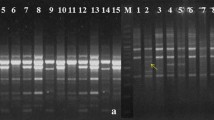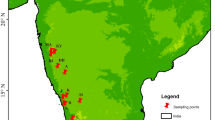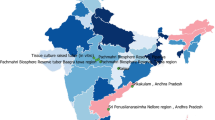Abstract
Boerhavia diffusa is extensively used in herbal medicines as well as in the Ayurvedic system, because it contains a set of clinically important compounds. In the present study, the genetic variability in Boerhavia diffusa between accessions of different geographical origin within the Indian territory is assessed through random amplified polymorphic DNA (RAPD) markers. Twenty-eight accessions of Boerhavia were screened with eighteen primers of which nine were found to be the most informative. The degree of polymorphism was found to be high in accessions collected from different places of Uttar Pradesh (Set II) in comparison to other states of India (Set I). A relatively lower level of polymorphism was recorded in accessions collected from diverse locations around Lucknow (Set III). Accessions from neighbouring geographical regions exhibited more similarity than those from distant regions (as revealed by the set I analysis). Certain diagnostic markers may be correlated with morphological character(s) such as plant type. BDL appeared most distinct and divergent from the rest of the accessions and the BDJ plant in set II also showed least similarity estimate. Fragments of 5.62 Kb and 4.47 Kb with primer GN59 was found to be unique for BDP and BD2 having ovate leaf character, whereas ovoid leaf genotype exhibited 0.79 Kb (GN34 primer) fragment. Similarly a unique band type (0.35 Kb) with primer GN83 was present in BDL and BD1 that share light pink flower. Jaccard's, and Nei and Li similarity coefficient values amongst the accessions were in the range of 0.22 to 0.89 and 0.33 to 0.93, respectively. Association of RAPD markers with the leaf characteristics, flower colour as well as with geographical locations has been made. This shows that RAPD markers are also useful for the study of genetic structure of Boerhavia populations.
Similar content being viewed by others
References
Adesina S.K. 1979. Anticonvulsant properties of the roots of Boerhavia diffusa. Quaterly Journal of Crude Drug Research 17: 84.
Agarwal R.R. and Dutt S.S. 1936. Chemical examination of Punar nava or Boerhavia diffusa Linn. II Isolation of an alkaloid punarnavine. Chemical Abstract 30: 3585.
Ahmed K. and Hossain A. 1968. Isolation, synthesis and biological action of hypoxanthin-9-L-arabinofuranoside. J. Biol. Agric. Sci. 11: 41.
Anand R.K. 1995. Biodiversity and tribal association of Boerhavia Boerdiffusa L. in Indo Nepal Himalayan Terai region. Flora and Fauna VI: 167-170.
Anonymous 1948. Wealth of India V I A-B: 199.
Anonymous 1988. Wealth of India V II A-B: 174.
Botstein D., White R.L., Skolnick M. and Davis R.W. 1980. Con-struction of a genetic linkage map in man using restriction fragment length polymorphism. Am. J. Hum. Genetics 32: 314-331.
Dean C. and Schmidt R. 1995. Plant Genomes. A current molecular description. Annu. Rev. Plant Physiol Plant Mol. Biol. 46: 395-418.
Debener T., Christian B. and Mattiesh L. 1996. RAPD analysis of genetic variation between a group of rose cultivars and selected wild rose species. Molecular Breeding 2: 321-327.
Heywood V.H. 1978. Flowering plants of the world. Oxford University Press, pp 69-70.
Jain G.K. and Khanna N.M. 1989. Punarnavoside. A new antifibrinolytic agent from Boerhaavia diffusa Linn. Indian J. Chem.V 28: 163-166.
Kodata S., Lami N., Tezuka Y. and Kikuchi T. 1989. Constituents of the roots of Boerhavia diffusa Linn. I. Examination of sterols and structures of new rotenoids (boeravinones A and B). Chemi-inhibcal and Pharmaceutical Bulletin V 37: 3214-3220.
Lami N., Kodata S., Tezuka Y. and Kikuchi T. 1990. Constituents of the roots of Boerhavia diffusa Linn. II Structure and steriochemistry of a new rotenoids boeravinone C2. Chemical and Pharmaceutical Bulletin V 38: 1558-1562.
Lami N., Kodata S. and Kikuchi T. 1992. Constituents of the roots of Boerhavia diffusa Linn. IV Isolation and structure determination of boeravinones D, E and F. Chemical and Pharmaceutical Bulletin V 39: 1863-1865.
Mathur A. and Bhandari M.M. 1983. New biosystematic variants in Boerhavia diffusa Linn. growing in different soils. Geobios new reports 2: 35-38.
Misra A.N. and Tiwari H.P. 1971. Constituents of roots of Boerdiffusa havia diffusa. Phytochemistry 10: 3318.
Olukoya D.K., Tdika N. and Odugbemi T. 1993. Antibacterial activity of some medicinal plants from Nigeria. J. Ethnopharmocology 39: 69-72.
Rawat A.K., Mehrotra S., Tripathi S.C. and Shome U. 1997. Hepatoprotective activity of Boerhavia diffusa Linn. roots-a popular Indian ethnomedicine. J. Ethnopharmocology. 56: 61-66.
Sangwan R.S., Sangwan N.S., Jain D.C., Kumar S. and Ranade S.A. 1999. RAPD profile based genetic characterization of chemotypic variants of Artemisia annua L. Biochem. Mol. Biol. Int. 46: 935-944.
Sangwan R.S., Yadav U. and Sangwan N.S. 2000. Isolation of genomic DNA from defatted oil seed residue of opium poppy (Papaver somniferum). Plant Molecular Biology Reporter 18: 265-270.
Sangwan N.S., Yadav U. and Sangwan R.S. 2001. Molecular analysis of genetic diversity in elite Indian cultivars of essential oil trade types of aromatic grasses (Cymbopogon species). Plant Cell Reports 20: 437-444.
Verma H.N. and Awasthi L. 1979. Antiviral activity of Boerhavia diffusa Linn. tiroot extract and physical properties of virus inhibcal itor. Can. J. Bot. 57: 926-932.
Verma S.K. 1983. Some flower colour variants in the flora of Bihar. Biol. Bull. India 5: 50-52.
Williams J.G.K., Kubelik A.R., Livak K.J., Rafalski J.A. and Tingey S.V. 1990. DNA polymorphism amplified by arbitrary primers are useful as genetic markers. Nucleic Acids Research 18: 6531-6535.
Author information
Authors and Affiliations
Rights and permissions
About this article
Cite this article
Shukla, N., Sangwan, N., Misra, H. et al. Genetic diversity analysis in Boerhavia diffusa L. of different geographic locations in India using RAPD markers. Genetic Resources and Crop Evolution 50, 587–601 (2003). https://doi.org/10.1023/A:1024407314784
Issue Date:
DOI: https://doi.org/10.1023/A:1024407314784




